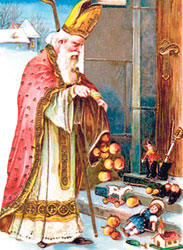What is Christmas without Santa?
A Christmas morning with empty stockings and a feeling of
disappointment that the
mysterious, yet jolly old man did not make his annual visit?
If you knew who the real Santa is and what he represents, you would think different, because without him during Christmas, there would be far more missing than meets the eye.
The real Santa – otherwise known as Father Christmas,
St. Nicholas, St. Nick, or Kriss Kringle, is far more than simply a plump old man who climbs through chimneys and windows of the world every Christmas Eve night.
The young St. Nicholas was born in Patara, Turkey in the third
century AD. He became Bishop Myra, and was known throughout the land for his generosity to those in need, his love for children and his concern for sailors and ships.
Under the Roman Emperor of that time, who ruthlessly
persecuted Christians, Bishop Nicholas suffered for his faith, was exiled and imprisoned. The prisons were so full of bishops, priests and deacons, there was no room for the real criminals – murderers, thieves and robbers.
The hardship that St. Nicholas suffered did not dampen his spirit though; he continued to do as much as he could to help the poor and the needy. He brought to life the Christmas spirit of giving, and many of his good deeds have formed the Christmas traditions we look forward to today.
Have you ever
wondered why you leave stockings out for Santa to fill with presents?
Read on.The story goes that a poor man was left with no means of
providing dowries for his three daughters. (In the olden days, a young woman's father had to offer prospective husbands something of value – a dowry. The larger the dowry, the better the chance that a young woman would find a good husband. Without a dowry, a woman was unlikely to marry.) This poor man's daughters,
without dowries, were therefore destined to be sold into slavery.
Mysteriously, on three different occasions, a bag of gold appeared in their home – providing the
needed dowries. The bags of gold, tossed through an open window, are said to have landed in
stockings or shoes left before the fire to dry. This led to the custom of children hanging stockings or
putting out shoes, eagerly awaiting gifts from Saint Nicholas. Sometimes the story is told with gold balls instead of bags of gold. That is why three gold balls,
sometimes represented as oranges, are one of the symbols for
St. Nicholas. And so, St. Nicholas is a gift-giver.
Many ancient legends also speak of St. Nicholas as a protector of
children and sailors.
The Father Christmas we know best though, is a symbol of Christmas – not simply the exchange of the gifts themselves, but of the act of giving and of
selflessness.
This is the true spirit of Christmas – a spirit that can last throughout the year and not just during the festive season, when
trying to figure out what to put down on your Christmas wish list, and when anticipating Santa's visit.
So when you hang up your
stockings and lay out the milk and cookies, think of the real Santa who will come into your home that night – and keep his spirit – the Christmas spirit, alive the whole year through!
|

